- genevb's home page
- Posts
- 2025
- 2024
- 2023
- 2022
- September (1)
- 2021
- 2020
- 2019
- December (1)
- October (4)
- September (2)
- August (6)
- July (1)
- June (2)
- May (4)
- April (2)
- March (3)
- February (3)
- 2018
- 2017
- December (1)
- October (3)
- September (1)
- August (1)
- July (2)
- June (2)
- April (2)
- March (2)
- February (1)
- 2016
- November (2)
- September (1)
- August (2)
- July (1)
- June (2)
- May (2)
- April (1)
- March (5)
- February (2)
- January (1)
- 2015
- December (1)
- October (1)
- September (2)
- June (1)
- May (2)
- April (2)
- March (3)
- February (1)
- January (3)
- 2014
- December (2)
- October (2)
- September (2)
- August (3)
- July (2)
- June (2)
- May (2)
- April (9)
- March (2)
- February (2)
- January (1)
- 2013
- December (5)
- October (3)
- September (3)
- August (1)
- July (1)
- May (4)
- April (4)
- March (7)
- February (1)
- January (2)
- 2012
- December (2)
- November (6)
- October (2)
- September (3)
- August (7)
- July (2)
- June (1)
- May (3)
- April (1)
- March (2)
- February (1)
- 2011
- November (1)
- October (1)
- September (4)
- August (2)
- July (4)
- June (3)
- May (4)
- April (9)
- March (5)
- February (6)
- January (3)
- 2010
- December (3)
- November (6)
- October (3)
- September (1)
- August (5)
- July (1)
- June (4)
- May (1)
- April (2)
- March (2)
- February (4)
- January (2)
- 2009
- November (1)
- October (2)
- September (6)
- August (4)
- July (4)
- June (3)
- May (5)
- April (5)
- March (3)
- February (1)
- 2008
- 2005
- October (1)
- My blog
- Post new blog entry
- All blogs
Run 14 luminosity steps
Starting last week, C-AD has begun missteering the beams at STAR to reduce luminosity mid-fill to help achieve the trigger goals of the HFT (running at high luminosities has been surmised to be detrimental to that program). Every ~half hour, the beams are steered a little bit closer together again until the beams are back together and the luminosity continuously drops along its original trajectory. Here are a few fills showing this pattern of zdcx [Hz] vs. time [sec] (arbitrary 0), followed by a zoom in of just one fill:

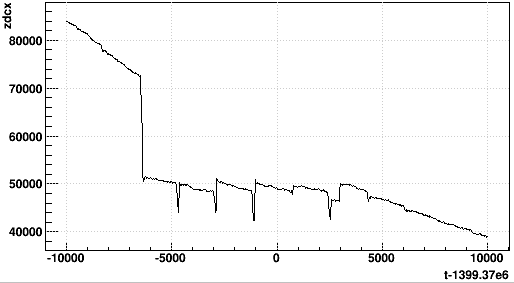
This raises a question about whether these steering events have any notable impact on TPC luminosity-dependent distortion corrections. A previous study has shown that the RICH scalers are stored with some lag time on the order of ~1 second (possibly more): is the change in luminosity rapid enough that the RICH scalers are significantly inaccurate for the data to which they are being applied?
To start the discussion, here is a plot using RICH scalers from the database (~60 second durations for each point, recorded every ~30 seconds) during a run where a steering change happened mid-run. This is run 15126011, and it appears to be rather typical of the luminosity steps at the steering changes:
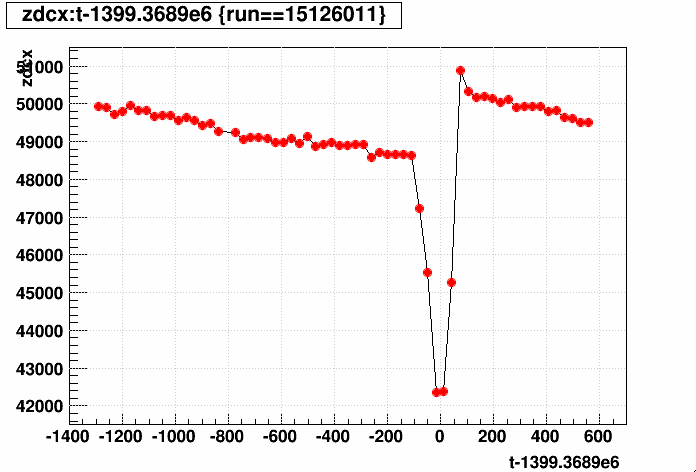
It appears that about 6-to-8 data points are involved in the "event", implying ~3-4 minutes! This is much longer than SpaceCharge decay rate.
This data suggests a change rate (slope) of order ~150 Hz/sec. One can then ask if this is on the order of what we typically see in the normal running, but the question cannot be answered well from the database data, as there are certainly fluctuations which occur more rapidly than can be seen in the 60-second averages. The DAQ stream contains ~1 second averages, and will serve as a better metric of what we already tolerate in terms of RICH scaler errors due to latency.
I should note that a second form of error between RICH scalers and TPC distortions occurs, which should probably also be quantified. SpaceCharge & GridLeak calibrations use a relationship between mean scaler values and mean SpaceCharge measurements, and one can see on plots of SpaceCharge vs. rich scalers that individual fills follow slightly different paths in this space. This means that using the average has some variance (error) for any individual recording.
-Gene
___________________
Update with analysis (2014-05-12):
We produced all st_physics data from run 15126011 so that we could get the 1-second scalers. Here is the same zdcx vs. t plot with the 1-second [black] and 30-second [red] scalers overlaid, with a zoom of the steering-event region:
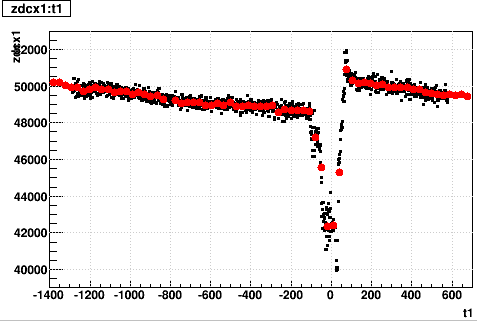
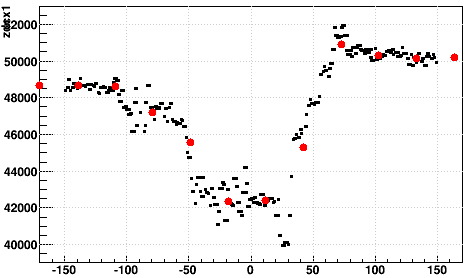
Next is Δ(zdcx)/Δ(t) between 1-second scaler readings vs. t, in 2D and a 1D "profs" version to give a sense of RMS:

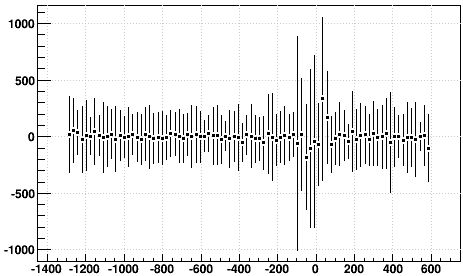
One can see that the rate of zdcx change is notably more variable during the steering, with values larger than ±2000 Hz/sec (much larger than the systematic ~150 Hz/sec changes I saw from the 30-second scalers). If I use t<-160, I get RMS of somewhere between ~240 and ~290 Hz (depending on including zdcx1=zdcx2, where scalers haven't actually updated before the next second, since the scalers update a little slower than once per second). The same for |t|<70 (during the steering event) gives between ~610 and ~730 Hz. I will call this σlag to the scalers, under the assumption that the scalers have a ~1 second lag.
The other part of this is what I will call σfill to the scalers, whereby each fill may occupy a different curve in the SpaceCharge vs. zdcx space. To get a rough measurement of it for this year's data, I looked at Zhengqiao's preliminary AuAu200 SC&GL calibration files. Here is his sc vs. zdcx:
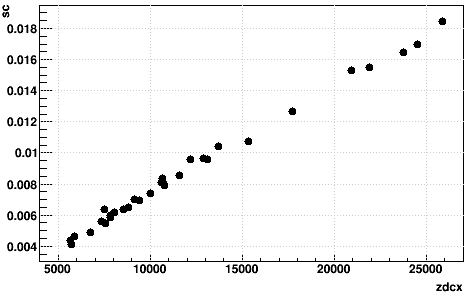
His fit to this gave sc = 6.784e-7 * (zdcx + 974). Turning this sc = ƒ(zdcx) around to get zdcx = g(sc), one can obtain zdcx - g(sc) to get an estimate of σfill:

This distribution has an RMS of ~400 ± 50 Hz.
Now, putting the pieces together, we can say:
σscalers = √(σlag2 + σfill2)
σSC = 6.784e-7 * σscalers (calibration result)
σDCA = ~100 * σSC (approximate and reasonable conversion)
Normal conditions:
σscalers = √(~2502 + ~4002) = ~470 Hz
σSC = ~3.2e-4
σDCA = ~320 μm
Steering event conditions:
σscalers = √(~6502 + ~4002) = ~760 Hz
σSC = ~5.2e-4
σDCA = ~520 μm
Given the limited statistics used to make these calculations, it's fair to say that they are only rough estimates. But it is probably reasonable to conclude as follows:
Under normal operating conditions, variations in the RICH scalers used to determine SpaceCharge distortion corrections contribute ~1/3rd of a millimeter of projection error to tracks at the primary vertex. Steering event conditions raise this projection error contribution to ~½ mm. These contributions are combined with an instrinsic TPC projection error of typically ~2.5-3 mm to the primary vertex. These projection errors will be slightly less at larger radii (less projection distance from the inner TPC), such as the radius of the SSD or IST sensors.
-Gene


This raises a question about whether these steering events have any notable impact on TPC luminosity-dependent distortion corrections. A previous study has shown that the RICH scalers are stored with some lag time on the order of ~1 second (possibly more): is the change in luminosity rapid enough that the RICH scalers are significantly inaccurate for the data to which they are being applied?
To start the discussion, here is a plot using RICH scalers from the database (~60 second durations for each point, recorded every ~30 seconds) during a run where a steering change happened mid-run. This is run 15126011, and it appears to be rather typical of the luminosity steps at the steering changes:

It appears that about 6-to-8 data points are involved in the "event", implying ~3-4 minutes! This is much longer than SpaceCharge decay rate.
This data suggests a change rate (slope) of order ~150 Hz/sec. One can then ask if this is on the order of what we typically see in the normal running, but the question cannot be answered well from the database data, as there are certainly fluctuations which occur more rapidly than can be seen in the 60-second averages. The DAQ stream contains ~1 second averages, and will serve as a better metric of what we already tolerate in terms of RICH scaler errors due to latency.
I should note that a second form of error between RICH scalers and TPC distortions occurs, which should probably also be quantified. SpaceCharge & GridLeak calibrations use a relationship between mean scaler values and mean SpaceCharge measurements, and one can see on plots of SpaceCharge vs. rich scalers that individual fills follow slightly different paths in this space. This means that using the average has some variance (error) for any individual recording.
-Gene
___________________
Update with analysis (2014-05-12):
We produced all st_physics data from run 15126011 so that we could get the 1-second scalers. Here is the same zdcx vs. t plot with the 1-second [black] and 30-second [red] scalers overlaid, with a zoom of the steering-event region:


Next is Δ(zdcx)/Δ(t) between 1-second scaler readings vs. t, in 2D and a 1D "profs" version to give a sense of RMS:


One can see that the rate of zdcx change is notably more variable during the steering, with values larger than ±2000 Hz/sec (much larger than the systematic ~150 Hz/sec changes I saw from the 30-second scalers). If I use t<-160, I get RMS of somewhere between ~240 and ~290 Hz (depending on including zdcx1=zdcx2, where scalers haven't actually updated before the next second, since the scalers update a little slower than once per second). The same for |t|<70 (during the steering event) gives between ~610 and ~730 Hz. I will call this σlag to the scalers, under the assumption that the scalers have a ~1 second lag.
The other part of this is what I will call σfill to the scalers, whereby each fill may occupy a different curve in the SpaceCharge vs. zdcx space. To get a rough measurement of it for this year's data, I looked at Zhengqiao's preliminary AuAu200 SC&GL calibration files. Here is his sc vs. zdcx:

His fit to this gave sc = 6.784e-7 * (zdcx + 974). Turning this sc = ƒ(zdcx) around to get zdcx = g(sc), one can obtain zdcx - g(sc) to get an estimate of σfill:

This distribution has an RMS of ~400 ± 50 Hz.
Now, putting the pieces together, we can say:
σscalers = √(σlag2 + σfill2)
σSC = 6.784e-7 * σscalers (calibration result)
σDCA = ~100 * σSC (approximate and reasonable conversion)
Normal conditions:
σscalers = √(~2502 + ~4002) = ~470 Hz
σSC = ~3.2e-4
σDCA = ~320 μm
Steering event conditions:
σscalers = √(~6502 + ~4002) = ~760 Hz
σSC = ~5.2e-4
σDCA = ~520 μm
Given the limited statistics used to make these calculations, it's fair to say that they are only rough estimates. But it is probably reasonable to conclude as follows:
Under normal operating conditions, variations in the RICH scalers used to determine SpaceCharge distortion corrections contribute ~1/3rd of a millimeter of projection error to tracks at the primary vertex. Steering event conditions raise this projection error contribution to ~½ mm. These contributions are combined with an instrinsic TPC projection error of typically ~2.5-3 mm to the primary vertex. These projection errors will be slightly less at larger radii (less projection distance from the inner TPC), such as the radius of the SSD or IST sensors.
-Gene
Groups:
- genevb's blog
- Login or register to post comments
